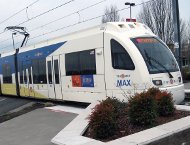5/17/2011
Oregon: Study Finds Light Rail System Rarely UsedDespite spending billions on transit, Portland, Oregon residents depend on automobiles for their transportation needs.

A study released earlier this month by the Cascade Policy Institute questioned whether pricey mass transit options in Portland, Oregon are really being used by the public. The city has been a leader in securing funding for various forms of passenger rail and trolley systems. The Obama administration, for example, pledged $745 million in federal gas tax dollars to pay for the construction of a $1.5 billion, 7.3 mile light rail project connecting Portland to Milwaukie. Transportation Secretary Ray LaHood has singled out the city's priorities as for praise.
"By adding innovative transit opportunities, Portland has become a model livable community, a city where public transportation brings housing closer to jobs, schools, and essential services," LaHood wrote in March.
The Cascade Policy Institute wanted to verify the claim that the TriMet transit system was able to move more passengers than a standard bus line. The researchers did so by attending five special events where use of mass transit would make the most sense, including the final playoff game for the Portland Trail Blazers. The events were spread throughout the year to examine the effects of different weather conditions on transit use. City officials have never made a study of this sort.
"This is important because transportation planners at Metro, TriMet, ODOT and other agencies routinely make multi-billion-dollar decisions based on travel surveys, computer models or simply their own personal beliefs about how people should travel," Cascade President John A. Charles, Jr wrote in his report. "They rarely have any direct knowledge of how people actually travel under specific conditions of time, mode availability, parking pricing and geographic constraints."
The Cascade team counted a total of 47,666 individual attendees, noting how many headed toward the venue from a light rail station and how many arrived by automobile, bicycle or foot. At best, 21 percent arrived by rail to see the Trail Blazers. At worst, the opening of the Gresham Civic Station saw just 2 percent arrive by rail. On average, rail accounted for just 11 percent of the trips recorded.
"The field research shows that continued use of the phrase 'high-capacity transit' by local planners to describe the regional rail program is Orwellian," Cascade President John A. Charles, Jr. said in a statement. "Light rail is actually a low-capacity system, and the streetcar is simply irrelevant. TriMet's buses carries two-thirds of all regional transit trips on a daily basis, and that's the service that should be recognized as high-capacity transit. Unfortunately, bus service is being sacrificed by TriMet in order to build costly new rail lines that carry relatively few people."
A copy of the report is available in a 1.2mb PDF file at the source link below.


